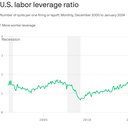This ratio shows how workers still have the upper hand

More than twice as many workers quit their jobs than were laid off or fired in January.
Why it matters: Workers still had the upper hand over employers, even as media reports of layoffs kicked up at the start of the year.
How it works: This "labor leverage ratio" is a measure developed by economist Aaron Sojourner, a senior researcher at Upjohn Institute. He uses the JOLTS data from the Labor Department that tracks job turnover — and separates "quits" from "discharges," or firings and layoffs.
- When more workers are quitting than getting let go, it's a sign of strong employee bargaining power. Workers feel confident that they have better options (or have already found one).
- When more workers are let go than quit voluntarily — that's no bueno, a sign that companies are cutting staff and workers aren't seeing much opportunity. As you can see from the chart above, the number falls during recessions.
The big picture: The leverage ratio surged to record levels during the Great Resignation — when quit rates were super high.
- Worker leverage has come down from those heady days, but it's still higher than before the pandemic.
- The still-elevated labor leverage helps explain the record levels of strikes.
Zoom in: Labor leverage is still very high in the industries that are doing the most hiring — accommodation and food services (4.9 quits per 1 firing), leisure and hospitality (3.85 to 1), healthcare (3.79 to 1), and retail (3.48 to 1).
What to watch: The jobs report will be out Friday morning to offer a snapshot of the February job market.